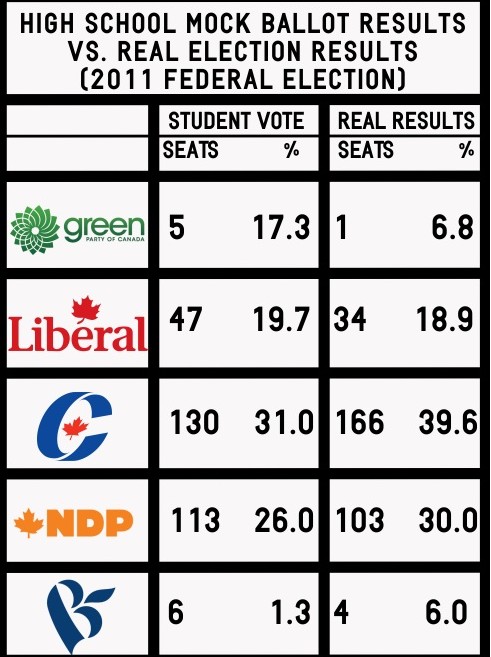If people were to read recent Conservative Party pamphlets found at the University of Calgary that had the slogan, “Let the lefties run your campus, help the Conservatives run the country,” they might assume most young people vote for left-wing parties.
But when hundreds of thousands of Canadian high school students under voting age casted mock ballots in the 2011 federal election, they voted Stephen Harper into a minority government. The results from the mock ballot were similar to the actual election.
“The fact that students have elected, federally, several Conservative governments with us does indicate, at least, that it would be very incorrect to assume that young people are voting more left-of-centre all the time,” said Emily Barrette, project manager at CIVIX.
CIVIX, a non-partisan group with a goal to educate elementary and high school students on civic opportunities, created the mock election as part of a program called Student Vote.
Barrette said the 2011 Student Vote results closely reflected the results of the actual election. She said it’s generally the trend found with other elections.
The Conservatives received 31 per cent of votes, and 42.2 per cent of all seats in the mock ballot. The New Democratic Party (NDP) came in second with 26 per cent of the votes and 37.6 per cent of all seats. More than 560,000 students participated in Student Vote.
In Alberta, where the Conservatives won all but one riding in the 2011 election, 92.9 per cent of seats went to the party in the mock election.
Quebec was swept up in the Orange Crush of the NDP in 2011, winning 59 of 75 seats. The mock ballot had 73.3 per cent of seats go to the NDP.
Despite the fact most students who voted in the 2011 Student Vote are now eligible to vote, Barrette said voting outcomes are still in flux.
“Like the average population, students don’t always vote for the same party at every level of government in every election that we do,” she said.
Student Vote had been essentially mandatory for schools participating in the program. Participating students did not need to worry about having the right ID or finding time to vote.
In 2011, 38.8 per cent of Canadians 18-24 years old voted in the election, according to Statistics Canada.
Barrette said students have to find something that can motivate them to vote.
“As with any election for young people, the motivating factor is to find something in politics that you care about or that reflects your views and your ideals and have that be a basis of making your decision,” Barrette said.
Jon Pammett, political science professor at Carleton University, said there is an information cost when young people start voting. They have to learn about the candidates, party platforms, and the history of the parties.
“You have to go and get some information and be at least innately interested enough to undertake that activity.” Pammett said, “Some obviously are, but others say, well maybe not now.”
“For a lot of younger people,” he said, “voting becomes not so much an expressive act, as an instrumental act,” he said. “ ‘I’ll vote if it will accomplish something. I’ll vote if there’s a real reason to vote.’ ”






